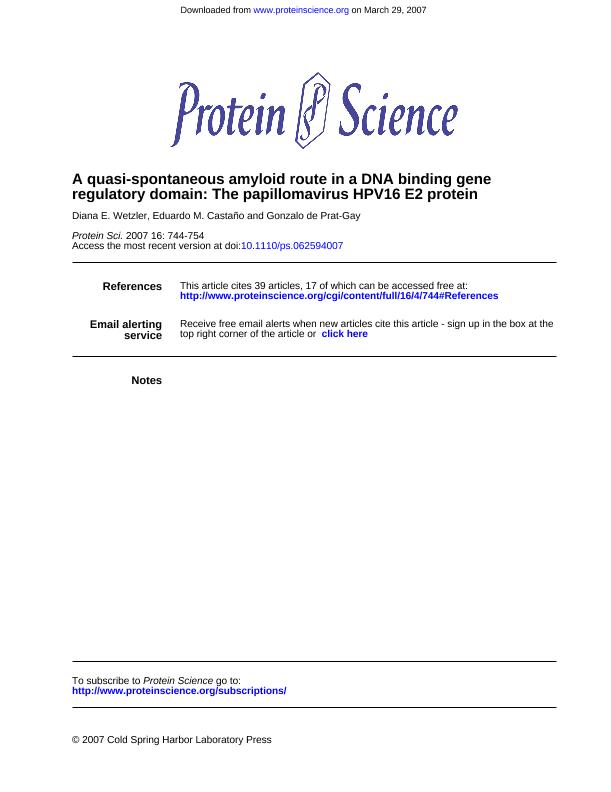Artículo
A quasi-spontaneous amyloid route in a DNA binding gene regulatory domain: The papillomavirus HPV16 E2 protein
Fecha de publicación:
12/2007
Editorial:
Wiley
Revista:
Protein Science
ISSN:
0961-8368
e-ISSN:
1469-896X
Idioma:
Inglés
Tipo de recurso:
Artículo publicado
Clasificación temática:
Resumen
The DNA binding domain of papillomavirus E2 proteins is at the center of the regulation of gene transcription and replication of the virus. Its unique fold consists of a beta-barrel domain that combines an eight-stranded dimeric beta-barrel core interface with two symmetrical DNA binding alpha-helices and other two helices, packed against the central barrel. Treatment with low amounts of trifluoroethanol readily leads to a mostly beta-sheet oligomeric species, with a loss of near-UV circular dichroism signal and increase in its ANS binding capacity, indicating that buried hydrophobic surfaces become accessible to the solvent. This species subsequently undergoes a slow transition into amyloid aggregates as determined by light scattering and Congo red and thioflavin T binding. Electron microscopy shows short amyloid fibers with a curly aspect as the end product. The amyloid route is completely prevented by addition of stoichiometrical amounts of specific DNA, strongly suggesting that unfolding of the DNA binding alpha-helix is required for the formation of the intermediate. The slow nature of this expanded beta-oligomeric species and the availability of several different conformational probes make it an excellent model for investigating amyloid mechanisms. The mild perturbation required for entering an amyloid route is indicative of a preexisting equilibrium. Oligomerization processes are required for the assembly of transcription initiation and DNA replication machineries, where proteins from different viruses must come together with host cell proteins. The E2 protein is a virus-encoded multifunctional master regulator that may exert one of its multiple functions through its ability to oligomerize
Palabras clave:
Protein Aggregation
,
Hpv-E2
,
Oligomers
Archivos asociados
Licencia
Identificadores
Colecciones
Articulos(IIBBA)
Articulos de INST.DE INVEST.BIOQUIMICAS DE BS.AS(I)
Articulos de INST.DE INVEST.BIOQUIMICAS DE BS.AS(I)
Articulos(IQUIBICEN)
Articulos de INSTITUTO DE QUIMICA BIOLOGICA DE LA FACULTAD DE CS. EXACTAS Y NATURALES
Articulos de INSTITUTO DE QUIMICA BIOLOGICA DE LA FACULTAD DE CS. EXACTAS Y NATURALES
Citación
Wetzler, Diana Elena; Castaño, Eduardo Miguel; de Prat Gay, Gonzalo; A quasi-spontaneous amyloid route in a DNA binding gene regulatory domain: The papillomavirus HPV16 E2 protein; Wiley; Protein Science; 16; 4; 12-2007; 744-754
Compartir
Altmétricas




